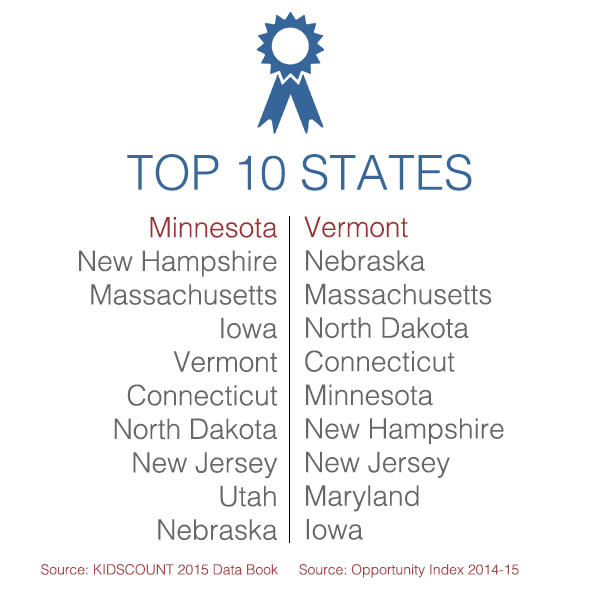New report reinforces child well-being essential for opportunity
 •
•
This year’s KIDS COUNT report by the Annie E. Casey Foundation paints a stark picture of an uneven economic recovery that has left behind millions of low-income working families and children of color. Nearly 1 in four children – 18.7 million – now live in low-income working families, an increase of 1.7 million since 2008.
Yet we know that if we are going to expand opportunity to more Americans, we have to ensure that all of our children have access to good schools and health care and that their parents are able to get jobs that pay family-sustaining wages.
The 2015 Data Book serves as an urgent call-to-action for all of us to focus on solutions that will expand access to the American Dream for the rising generation.
The KIDS COUNT data tracks closely with the Opportunity Index. Nine of the 10 states that rank highest in child well-being in this year’s Data Book align with the top scoring states for opportunity on the Index. KIDS COUNT measures dozens of indicators, several of which are similar to the Index such as poverty, the number of disconnected youth and the number of high school students who graduate on time, though the Index’s focus is not exclusively on children.

Results are similar for the lowest scoring states – nine of the 10 are aligned on both data measures: South Carolina, West Virginia, Arkansas, Alabama, Arizona, Nevada, Louisiana, New Mexico, Mississippi.
These data offer further evidence that investments in child well-being are critical if we are going to increase Opportunity Scores across the country and make sure our young people have access to meaningful education and career pathways that lead to economic security and prosperity at both the individual and community levels.
It’s hard to believe that the incidence of concentrated poverty – families living in neighborhoods where the overall poverty rate is 30 percent or higher – is on the rise. Fifteen years ago, 9 percent of children lived in places of concentrated poverty. By 2013, that figure climbed to 14 percent of American children. We have to work together to reduce these numbers.
KIDS COUNT also found that children of color are most at risk for economic instability. African-American children are twice as likely as the average child to live in high-poverty neighborhoods; Native American children are twice as likely to lack health insurance coverage; and Hispanic children are the most likely to have parents who lack a high school diploma. We know that low-income and children of color are also most at risk for disconnection from school and work when they become young adults – an outcome that hurts not just individuals but the social fabric of our neighborhoods and the vibrancy of our national economy.
The 2015 Data Book offers solutions that are supported by Opportunity Nation’s diverse coalition and which need to be front and center during the 2016 presidential race. These include promoting multiple pathways for students and young adults to get family-supporting jobs and ensuring access to high-quality early learning opportunities for low- and moderate-income children.
We are proud to partner with Annie E. Casey on opportunity-related issues and hope you will read and share this incredibly important data with your networks as we all work together to expand opportunity to young Americans.









